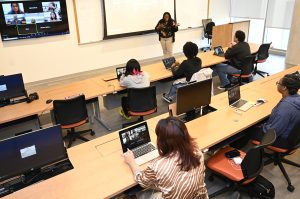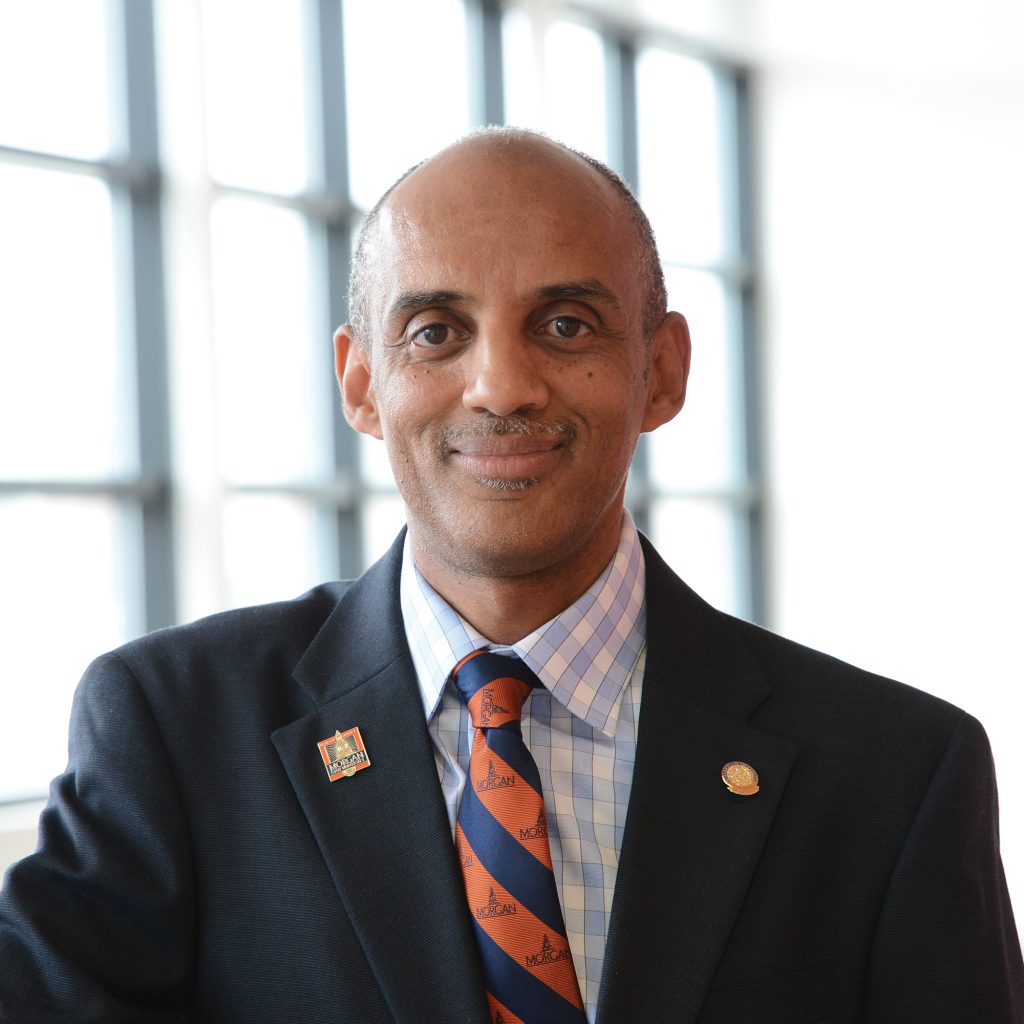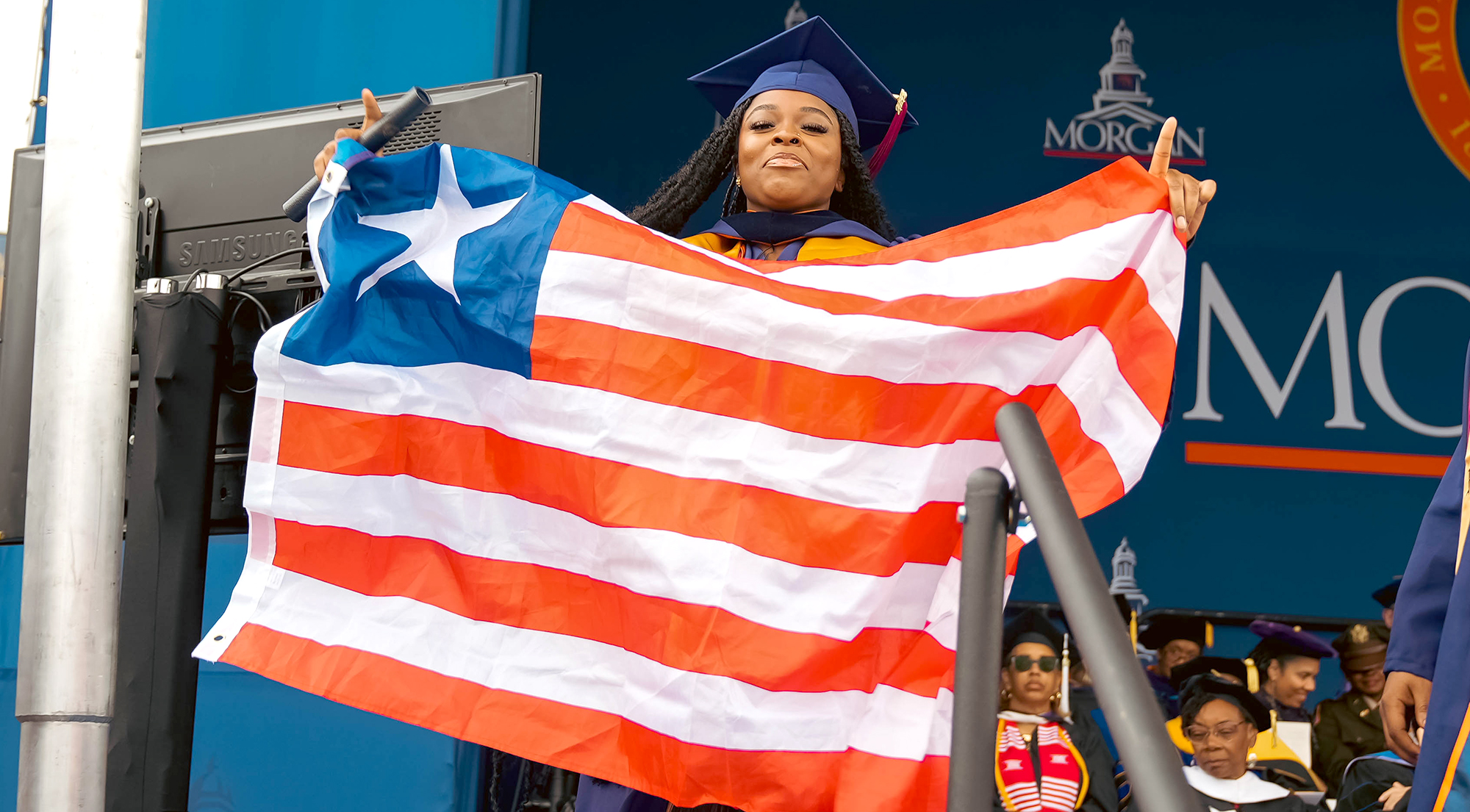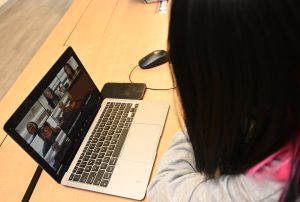By: Eric Addison
MSU Innovates to Achieve Its International Goals
Each one of us brought unique ideas and experiences to the table for discussion. The point of it was to learn how to accept others and be accepted as well.
-Jafar AL Quraishi, MSU Fall 2022 Architecture and Environmental Design Graduate
“Transformation Morgan 2030: Leading the Future,” Morgan State University’s (MSU’s) strategic plan for 2021–30, was released to the public after approval by the University’s Board of Regents in January 2022, as a surge of the new Omicron variant was wreaking havoc across the country. Goal 6 of the plan: “Accelerate Global Education Initiatives and Expand the University’s International Footprint,” called for big increases in study abroad and international student enrollment, among other major changes. But at launch time for those initiatives, U.S. higher education institutions found themselves struggling to recover from the COVID-19 pandemic’s devastation of their efforts to internationalize.
 After a downturn in internationalization during the preceding U.S. presidency, “2021 was supposed to be the change,” says Yacob Astatke, D.Eng., ’91 and ’10. Dr. Astatke is Morgan’s assistant vice president for International Affairs, a division created in 2012 by MSU President David K. Wilson. “We had an administration that was more friendly to international scholars and international partnerships, and so all of us were excited. But before the administration could put its policies in place, COVID came and hit us.”
After a downturn in internationalization during the preceding U.S. presidency, “2021 was supposed to be the change,” says Yacob Astatke, D.Eng., ’91 and ’10. Dr. Astatke is Morgan’s assistant vice president for International Affairs, a division created in 2012 by MSU President David K. Wilson. “We had an administration that was more friendly to international scholars and international partnerships, and so all of us were excited. But before the administration could put its policies in place, COVID came and hit us.”
The nation’s colleges and universities saw a 46% drop in new international students and a 15% decrease in total international enrollment in 2020–21, according to the Institute for International Education’s Fall 2021 International Student Enrollment Snapshot. Likewise, NAFSA: Association of International Educators reported a “dramatically” lower number of U.S. college students participating in study abroad that academic year, because of increased travel risks and limited funding. For its part, Morgan saw the University’s international student enrollment diminish by more than half, from 945 scholars, 12% of the total enrollment, in Spring 2018, to only 457, 5.4% of the student body, in Fall 2021.
Despite those historic challenges, however, Astatke says, MSU has made significant progress toward realizing the vision of Morgan Global.
(Morgan has been) beyond what I expected. The people are warm. Everyone is going out of his way or her way to help me acclimatize and settle in. Truly, you can see the Core Values being played out.
-Ifeyinwa Madu, MSU Industrial and Computational Mathematics Ph.D. Student
Virtual Connections
“President Wilson and Morgan’s other senior administrators halted all study abroad activities in March 2020, and for almost two years after that, we had almost no face-to-face study abroad, because COVID was still not under control,” Astatke recalls.
“So what we did was innovate,” he continues. “Back in 2019, I had attended several conferences and became aware that there was a new push toward virtual exchange and collaborative online international learning (VE/COIL),” educational approaches that use internet technology to connect students and faculty remotely. “I rearranged our division to focus on VE/COIL, and we quickly began recruiting and training faculty who were interested. I realized prior to COVID that, considering the difficulty for Morgan students in finding the funding and time to study abroad, virtual exchange and COIL would be another way of giving them some international learning experience. So between 2020 and 2021, when COVID prevented us from sending our students to study abroad, we significantly increased the number of students who were engaged in virtual exchange and COIL.”
Jafar AL Quraishi, ’22, was one of the students who benefited from COIL at Morgan. The recently graduated Bachelor of Science in Architecture and Environmental Design major joined with other students from around the world for an online cultural education experience hosted by Japan’s Kansai University, in Fall 2020, as part of one of his architecture courses at MSU.
“It was mostly students’ experience with each other, learning about each other’s culture and what was happening around the world,” he recalls. “For example, we had one student from Singapore who was living in Italy. She told us the COVID lockdown wasn’t as strict as it seemed on TV or in the newspapers. Each one of us brought unique ideas and experiences to the table for discussion. The point of it was to learn how to accept others and be accepted as well.”
Born in Iraq and raised in Jordan, Syria and Turkey before he came to the U.S. at age 17 with his family, AL Quraishi brought a wealth of cultural experience to the program, but he still found it beneficial: “On a scale of 10, it was an eight or nine experience,” he says.

Less than 6% of Black students in the U.S. study abroad, compared with 20% of Caucasians. And when you look at African Americans at (HBCUs), the average is actually 2%.
–Dr. Yacob Astatke, MSU Assistant Vice President for International Affairs
Enrollment Forecast
When we spoke with him last fall, Astatke discussed the “big challenge” of increasing Morgan’s enrollment of international students from the current number of 400 to 800, by 2030. Astatke anticipates gradual growth in the category, with the use of a new tool for recruitment.
“One handicap Maryland had, compared to other states, is that Maryland law used to forbid universities from signing with agencies to recruit students for them,” he explains. “As an example, the schools in California, Texas and New York are the three biggest attractors of international students in the U.S., and all the universities in those three states, and also Florida, use agents to recruit students for them. Agents have offices around the world, and you tell them the countries where you want to get students. They identify the students, help the students apply, help the students get admitted and even help the students get their visas. Fortunately, after a three-year struggle, the Maryland law was changed, in 2021. So one of the ways Morgan will be increasing its enrollment of international students, especially in countries like China and India, where it is very hard to recruit, is by using agencies.”
 “The large majority of our international students will come from Africa,” Astatke predicts, “because Africa has the youngest population in the world and also the fewest number of universities in the world.”
“The large majority of our international students will come from Africa,” Astatke predicts, “because Africa has the youngest population in the world and also the fewest number of universities in the world.”
Indeed, four of the top 10 countries of origin of Morgan’s international students are in Africa. Nigeria is the top contributor to the total, with 222 of its citizens enrolled. Morgan’s strategic partnership with Nigeria’s Tertiary Education Trust Fund (TETFund) is a major reason for that result. The five-year partnership, launched in May 2020, is designed to create a pathway for Nigerian students to pursue Ph.D.s and postdoctoral research in disciplines relevant to the developmental needs of Nigeria. The agreement provides the students with scholarships and other grants to fully fund their tuition, fees and living expenses for at least three years and also supports TETFund’s establishment of Centers of Excellence in Nigeria, institutions designed to increase the research capacity of Nigerian higher education through collaborative research with Morgan.
Ifeyinwa Madu, a computer science lecturer at The Federal Polytechnic Bauchi, in Bauchi State, Nigeria, is one of the 90-plus TETFund-sponsored Ph.D. students admitted to Morgan since Fall 2020. Selected for her cohort from more than 500 nominees, she arrived in the U.S. on Christmas Day 2021 and began pursuing her doctorate in Morgan’s Industrial and Computational Mathematics program last spring.
Coming to America was a journey she’d long prayed for, but her experience at Morgan, Madu says, has been “beyond what I expected. The people are warm. Everyone is going out of his way or her way to help me acclimatize and settle in. Truly, you can see the Core Values being played out…. Morgan is actually a spiritual environment, I discovered.”

‘A Bold Vision’
The pandemic’s disruption of study abroad also created an opportunity for Morgan. Working with two other senior international officers from Clark Atlanta and Tennessee State Universities, and with a Maryland-based nonprofit organization, Astatke utilized the quiet time afforded by the crisis to develop a new program: the HBCU Africa Coalition 100,000 Strong Africa Initiative.
“Less than 6% of Black students in the U.S. study abroad, compared with 20% of Caucasians. And when you look at African Americans at (HBCUs), the average is actually 2%. I estimate that 80% of HBCUs don’t even have a study abroad program, because of a lack of funding. Many HBCU students barely have enough money to pay their tuition and fees,” Astatke says. “The only way the statistic for Black HBCU students will go from 2% to 30% is by having a bold vision.”
 “Our 100,000 Strong Africa Initiative is modeled on President Obama’s 100,000 Strong Americas program, which had a goal of sending up to 100,000 students to Latin America to be engaged in experiential learning, volunteerism and study,” he explains. “We thought, ‘We can be ambitious and launch a similar program focused on Africa.’ Last May, we took the first 100 of the 100,000 Strong to Ghana.”
“Our 100,000 Strong Africa Initiative is modeled on President Obama’s 100,000 Strong Americas program, which had a goal of sending up to 100,000 students to Latin America to be engaged in experiential learning, volunteerism and study,” he explains. “We thought, ‘We can be ambitious and launch a similar program focused on Africa.’ Last May, we took the first 100 of the 100,000 Strong to Ghana.”
The participants attended a conference in Accra and stayed in Ghana two to three weeks after that event to engage in experiential learning.
“Our goal is to get funding from the State Department, from (nongovernmental organizations), from philanthropists and others to get scholarships for our 100,000 Strong Africa students to study abroad,” Astatke says.
E. Victoria, a Spring 2023 graduate of MSU’s Master of Landscape Architecture program, was in the inaugural group. Now owner of a landscape design and installation business, he benefited from an often itinerant youth, moving with his parents from Houston, Texas, to Baltimore City, where he went to high school; then to New York City for college, to New Mexico to serve with AmeriCorps and back to Baltimore, where he earned a degree in corporate communication from the University of Baltimore.
But international travel was never part of his plan, until an MSU Landscape Architecture professor, Archana Sharma, Ph.D., sent him an email inviting him to join 100,000 Strong Africa. He accepted immediately.
The program’s conference, “was a great opportunity where presenters discussed where we are (internationally) as HBCUs, as a collective, and explained the need to participate in internationalism vs. globalism, stressing that globalism can be a harm. Instead of globalism, we actually want to lean into internationalism, where we all know where we come from but are working together,” Victoria said last fall. Experiential learning was integrated into the entirety of the group’s stay in Ghana, he adds. It included travel to villages for architectural projects; leading impromptu teaching/learning sessions about landscape architecture for groups of students; and other activities.
(100,000 Strong Africa) has changed me. I came back with a mission. My capstone project is focused on bringing African symbolism into the landscape, particularly on HBCU campuses.
-E. Victoria, MSU Master of Landscape Architecture Graduate
Expanding Horizons
The emotional impact of the experience was “so big,” Victoria said. “It has changed me. I came back with a mission. My capstone project is focused on bringing African symbolism into the landscape, particularly on HBCU campuses. I’ve also been thinking about pursuing a Ph.D. at Morgan in Architecture, Urbanism and Built Environments, because I realize I don’t have enough space (in my master’s program) to cover this decolonization of landscape architecture.”
“Study abroad expands your horizons,” he said. “It stretches you. You don’t realize how tightly coiled you have been and how we can influence more than just our small town. And we can be influenced by the world.”
Looking ahead, Astatke anticipates that Morgan Global will continue to regain ground lost during the pandemic to move toward other objectives, including establishment of a campus outside the U.S. and development of partnerships with African universities to offer dual-degree academic programs.
“The key now,” Astatke says, “is building on our momentum and increasing our activities that support international partnerships.”





